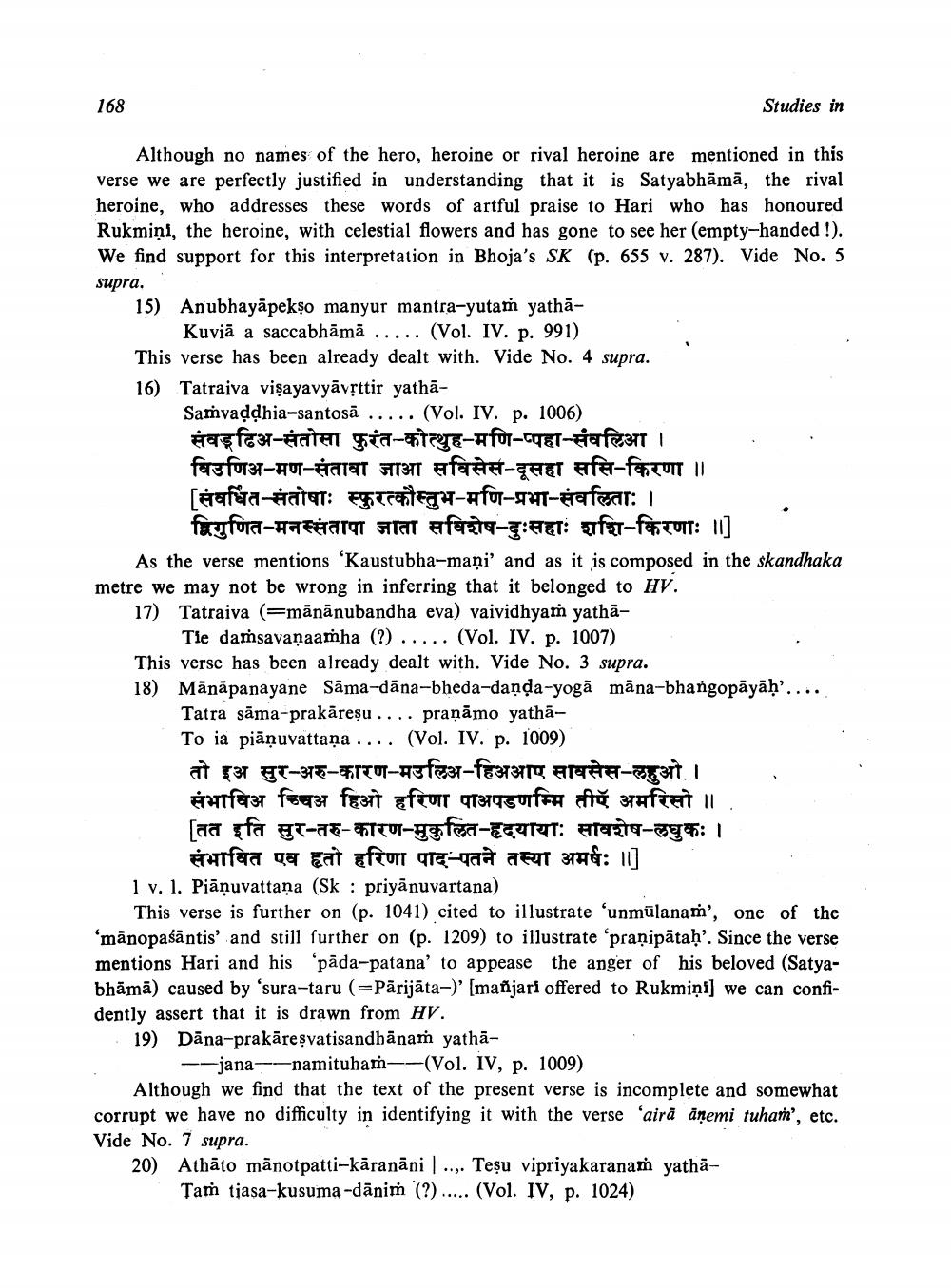________________
168
Studies in
Although no names of the hero, heroine or rival heroine are mentioned in this verse we are perfectly justified in understanding that it is Satyabhāmā, the rival heroine, who addresses these words of artful praise to Hari who has honoured Rukmiņi, the heroine, with celestial flowers and has gone to see her (empty-handed !). We find support for this interpretation in Bhoja's SK (p. 655 v. 287). Vide No. 5 supra. 15) Anubhayāpekso manyur mantra-yutam yathā
Kuvià a saccabhāmā ..... (Vol. IV. p. 991) This verse has been already dealt with. Vide No. 4 supra. 16) Tatraiva vişayavyāvșttir yathā
Samvaddhia-santosā ..... (Vol. IV. p. 1006)
Hersfeer-ratet gja-maya-af0c7ET-FESTI विउणिअ-मण-संतावा जाआ सविसेस-दूसहा ससि-किरणा ॥ [stafa Hatar: porte -fur-572-afsar:
fayfora-HTERATAT Frar afaitag:het: Tfa-facut: ll] As the verse mentions 'Kaustubha-maņi' and as it is composed in the skandhaka metre we may not be wrong in inferring that it belonged to HV. 17) Tatraiva (=mānānubandha eva) vaividhyam yathā
Tie daṁsavanaamha (?)..... (Vol. IV. p. 1007) This verse has been already dealt with. Vide No. 3 supra. 18) Mānāpanayane Sama-dāna-bheda-danda-yogā māna-bhangopāyāḥ'....
Tatra sāma-prakāreşu.... praņāmo yathāTo ia piāņuvattaña .... (Vol. IV. p. 1009) at 537 ET-378-HITO-AS FE37-f8373110, ATAE ESTI I . . संभाविअ च्चिअ हिओ हरिणा पाअपडणम्मि तीऍ अमरिसो ॥ . तित इति सुर-तरु-कारण-मुकुलित-हृदयायाः सावशेष-लघुकः ।
संभावित एव हृतो हरिणा पाद-पतने तस्या अमर्षः ॥] 1 v. 1. Pjāņuvattaņa (Sk : priyānuvartana)
This verse is further on (p. 1041) cited to illustrate ‘unmūlanam', one of the ‘mānopaśāntis' and still further on (p. 1209) to illustrate 'pranipätah'. Since the verse mentions Hari and his ‘pāda-patana' to appease the anger of his beloved (Satyabhāmā) caused by 'sura-taru (=Pārijāta-)' [mañjari offered to Rukmiņi] we can confidently assert that it is drawn from HV. 19) Dāna-prakāreșvatisandhānam yathā
--jana---namituham--(Vol. IV, p. 1009) Although we find that the text of the present verse is incomplete and somewhat corrupt we have no difficulty in identifying it with the verse 'airā āņemi tuham, etc. Vide No. 7 supra. 20) Athāto mānotpatti-kāranāni... Teşu vipriyakaranam yathā
Tam tiasa-kusuma-dānim (?) ..... (Vol. IV, p. 1024)




